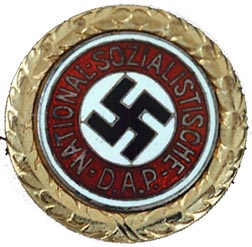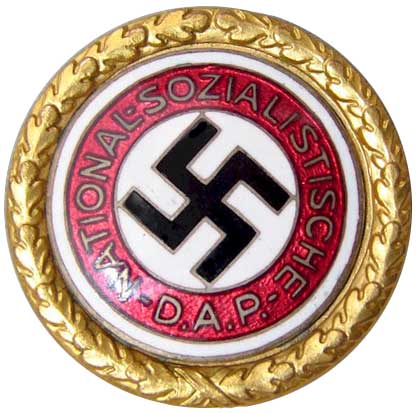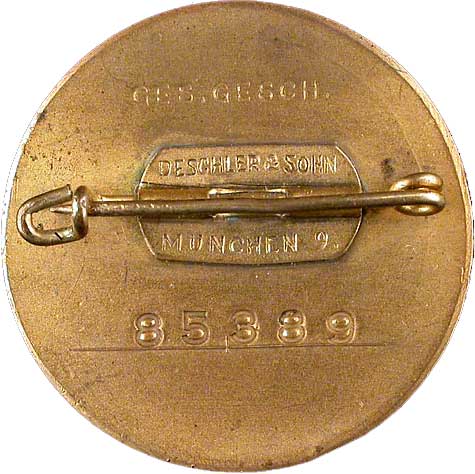
INTRODUCTION
The 30.5 mm Golden Party Badge of the NSDAP was exclusively designed for wear on a uniform. Essentially, in the larger 30.5mm size, the Golden Party Badge took its design from the standard enamel Nazi party membership pin surrounded by a thin white enamel border and a golden oak leaf wreath. The badge was fire gilded brass with the metal edges, letters and highlights in the enamel center silver plated. Because they were worn at every opportunity, frequently the silver plating of the letters wore off leaving the brass to show through underneath.
The Munich firm of Deschler & Son was the only producer of the 30.5mm badge.

THE FACE OF THE BADGE
As one of the highest awards of the Third Reich, the Golden Party Badge has the quality expected in a fine piece of jewelry. The face should feel smooth to the touch, and no enamel should cover periods, dashes or any part of the surrounding letters. All letters and the outline of the swastika were originally plated in silver, and there will often be traces of it remaining, with allowances for wear.
The wreath always has nine leaves per side, meeting in a ribbon under the letter "A" of "D.A.P.". The leaves should not have a pronounced center ridge, and should go all the way to the edge of the badge without a visible border. For some reason, Gold Party Badges made with a vertical military style pin attachment often have a very slightly more pronounced center ridge to the leaves.
In the 30.5mm version, the "O" in "SOZIALISTISCHE" should be almost perfectly round, and the "S" is slightly squashed. The hyphen or dash between "NATIONAL" and "SOZIALISTISCHE" should overhang the "L".
The gold finish is real gold, applied through a process call mercurial fire gilding. Gold is dissolved in a mercury solution, and then heated so the gold is released as vapour and adheres to the base brass of the badge. It is incredibly toxic and has caused many injuries, but leaves an incredible satin finish that is impossible to reproduce by other means. It is also very durable and does not tarnish, but will dull with use.
The red enamel on these badges should be translucent like glass, and raised dots or stippling should be visible underneath. While the back is flat, the front is slightly convex like a contact lens.

THE REVERSE OF THE BADGE
Numbered Badges
 The marks found on on
the back of original 30.5mm Gold Party Badges are "Ges. Gesch."
and the member's party number. Some badges also have the maker's name
stamped into the pin plate:
The marks found on on
the back of original 30.5mm Gold Party Badges are "Ges. Gesch."
and the member's party number. Some badges also have the maker's name
stamped into the pin plate:
MÜNCHEN 9.
One author suggests that members' badges between 1,000 and 10,000, only the number should appear, and not the "Ges. Gesch." or maker's name.
The "Ges. Gesch." sometimes appears as letters stamped on its own as shown left, or in a small recessed box as shown below.
The numbers have a distinctive style. It was previously thought that the only badges with individually stamped numbers were the original issue under 1,000. All others were stamped as a group by use of a small template which aligned the number perfectly. Badly misaligned numbers are an indication of a fake, however there can be some slight deviations in height in original badges. Another subtle feature of originals - and by no means do all originals have this feature - is a slight circle inscribed near the edge on the reverse of the badge. This is left by the machine that held the badge while the membership number was being impressed. Less frequently you will see a line on which the membership number sits. Numbers are pressed in rather than stamped. Stamped numbers create a distinctive distortion or bump around the edge of the numbers and are characteristic of a fake.
It is common for 30.5 mm badges have a hole on the back, but not essential. These are vent holes to allow expanding gas to escape when welding the enameled disk to the brass wreath base. Often the hole is underneath the pin plate, or the hole has been drilled to actually nick the corner of the plate. This indicates that the pin plate was attached sometimes before and sometimes after the hole was drilled.
Pin Attachments
Most pins were attached with an irregular, roughly rectangular pin plate with rounded ends, as shown in the examples to the left. These were notoriously fragile, and were often broken and replaced by their owners. Some original large badges were also issued with sturdier military style pins for tunic wear. See the section on attachments for more details.